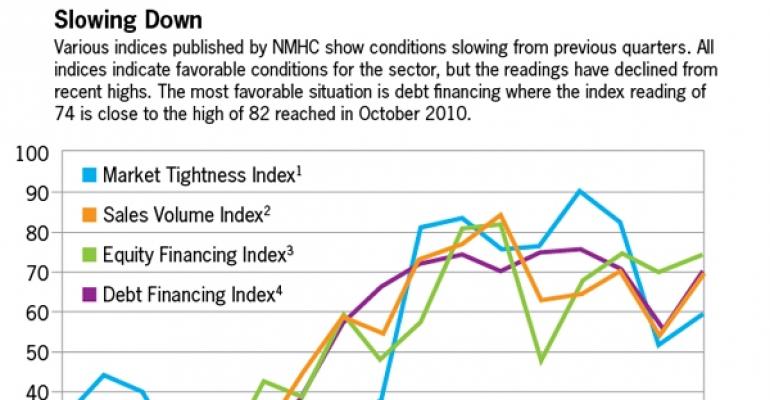It’s natural to worry about whether apartment markets will get overbuilt.
The development pipeline is robust. But market researchers at the at National Multi Housing Council’s annual meeting, held January 22-23 in Palm Springs, Calif., said that the sector remains in the clear—for now. While the pipeline in some markets is at worryingly high levels, the national supply is within normal levels.
Apartment developers now have plans to build roughly 1.4 million new apartments nationally, according to data from NMHC. More than half of the apartment companies report they are buying developable land, lining up financing and getting building permits, according to NMHC’s latest survey of its own members.
But many of those planned units are still just plans. “We don’t think all those 1.4 million units in the pipeline are real,” says Ron Witten, founder of apartment market advisory firm Witten Advisors. Many will not actually start construction for years, if they ever do.
That’s especially true in markets with high barriers to entry such as Boston, where it can take developers as long as seven years to get the permission to build from local officials needed to build. Cautious underwriting, limited debt capacity, rising land and construction costs and weaker rent growth may also keep many of those units from fruition.
“We think instead that starts, perhaps, aren’t even going to get back to 250,000 in the near term,” Witten reported at the NMHC conference. Other analysts gave similar estimates. That’s slightly more than last year, when multifamily starts finished at an annual rate of just 212,000.

The rate of construction is still below the demand for new apartments—even considering the lackluster economic recovery. Historically, the U.S. apartment market has needed roughly 300,000 new units per year to meet demand from renters. “Demand requirements outpace the supply pipeline,” said Jubeen Vaghefi, international director and leader of Jones Lang LaSalle’s Multifamily Capital Markets. “This year, expected deliveries of new product will be 12 percent below historical average delivery levels.”
There’s also a huge amount of pent-up demand for apartments.
During the recession, many potential renters put off striking out on their own to form new households. During those tough economic times, the number of households under the age of 35 shrunk, even though the number of people in that age bracket kept rising.
About 40 percent of those unformed households under 35 are “boomerang kids,” or adult children who are living in mom and dad’s basement, Witten says. He estimated that the hiccup in the rate of household formations has led to a shortfall of roughly 1.7 million households.
When these young people finally strike out on their own some will buy for-sale housing—provided they can get a mortgage. But many will rent apartments. Witten estimates that this pent up demand for apartments could total 500,000 units. NAREIT estimates the supply of new apartments is still 750,000 units short of keeping up with organic population growth.
Even some apartment markets with sharp increases in production are still far from overbuilt. South Florida, Las Vegas, Phoenix, Chicago and Los Angeles will be some of the top markets for supply deliveries in 2013, according to Jones Lang LaSalle.
“While markets like South Florida will experience outsized deliveries in 2013, in reality, those numbers are a fraction of what we’ve seen in the past—just 40 percent of the historical annual average,” said LaSalle’s Vaghefi. “After several years of meager deliveries, the sector is finally starting to respond to demand in the marketplace. We’ve got a long way to go before we cross that ‘bubble’ threshold—this pipeline is in no danger of bursting.”

